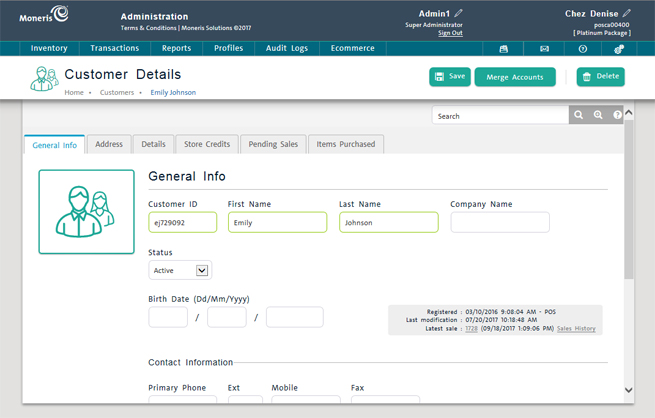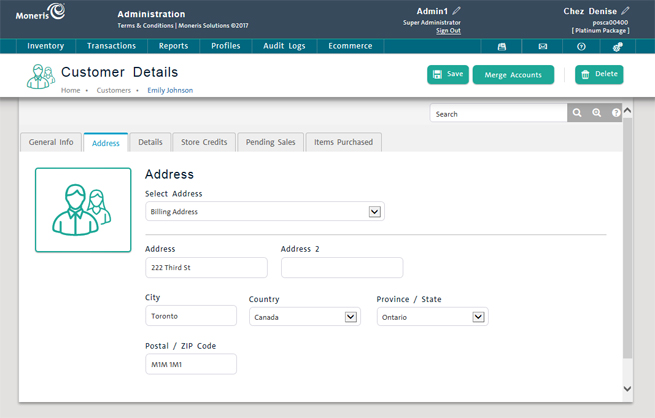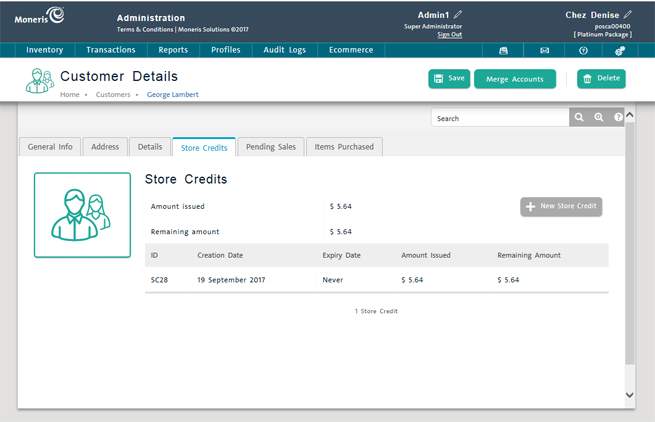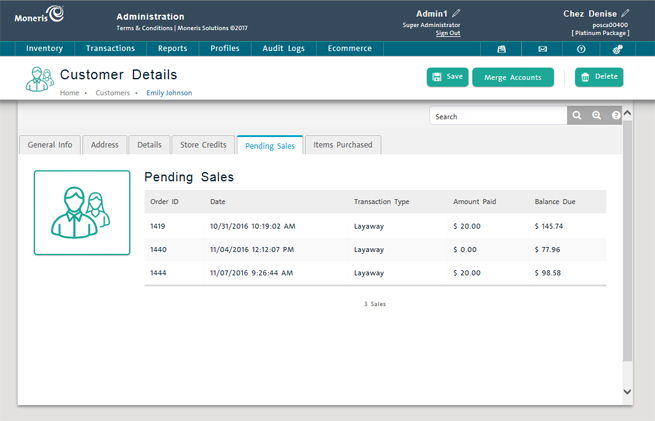
View summary customer information in the Customer Search Results screen. View customer details in the Customer Details screen.
On the PAYD Administration main screen, click Profiles.
On the Profiles menu, under the Customers section, click Search.
A list of all customers appears.
Search for the customer whose details you wish to view.
The customer list contains the following information for each customer in your database. The list is sorted in descending order by Registration Date.
Status - The status of the customer: Active or Inactive.
NOTE: Inactive customers cannot be assigned to a sale.
Customer ID - The ID used by the PAYD Pro PlusTM to identify the customer.
First name - The customer's first name.
Last name - The customer's last name.
Phone - The customer's primary phone number.
Email - The customer's email address, if one is provided.
NOTE: If your store is configured to email receipts to customers at the time of sale, the receipt is emailed to this address.
Registration Date - Date on which the customer was registered in the database (mm/dd/yy).
Uses ECommerce - This field indicates whether or not the customer uses the eCommerce module (based on whether the customer has created an online profile).
Click the heading of the column you want to sort on (clickable headings).
Click again on a heading to toggle between descending and ascending order.
Use the navigation bar at the bottom of the list. The current page is highlighted.

Find the customer record by:
Browsing the customer list.
OR
Using Search (see Searching Customers).
On the customer list, click the Customer ID.
The record appears in the Customer Details screen with the General Info tab selected.

Customer details are displayed in six tabs: General Information, Address, Details, Store Credits, Pending Sales and Items Purchased.
Click the General Info tab (the default tab).
Under the General Info section, the following details are displayed:
Customer ID - The ID used by PAYD Pro Plus to identify the customer (read-only).
First Name - The customer's first name.
Last Name - The customer's last name.
Company Name - The name of the company or the place of employment for the customer.
Status - The customer's status: Active or Inactive.
NOTE: Inactive customers cannot be assigned to a sale.
Birth Date -The customer's birthday in DD/MM/YYYY format.
Registered - The date and time on which the customer was registered (mm/dd/yy hh:mm:ss AM/PM) (read-only, cannot be edited).
Last modification - The date and time on which the customer's record was last modified (mm/dd/yy hh:mm:ss AM/PM). If the customer's record was never modified, the field is marked Never modified (read-only, cannot be edited).
Latest sale - The ID of the customer's latest sales order with the date and time (mm/dd/yy hh:mm:ss AM/PM). If the customer has no order history, the field is marked No sales history (read-only, cannot be edited).
TIP: To view details of the sales order in the Order Details view, click the ID link (see Viewing Order Details). To view the customer's order history in the Transactions Management view, click the Sales History button (see The Transactions Management View).
Under the Contact Information section, the following details are displayed:
Primary Phone - The customer's primary phone number (with extension if applicable).
Mobile - The customer's mobile phone number.
Fax - The customer's fax number.
Under the Email section, the following details are displayed:
Email: The customer's email address, if one is provided.
NOTE: If your store is configured to email receipts to customers at the time of sale, the receipt is emailed to this address.
Uses ECommerce - This label indicates whether or not this customer is registered to use the eCommerce website (read-only, cannot be edited).
Part Of Mailing List - This indicates whether or not this customer is part of the business' mass mailing list.
Reset Password - Click this button to reset the customer's password used for logon to the eCommerce website. Refer to Resetting eCommerce Passwords for more information.
NOTE: This button is only visible to merchants using the PAYD Pro Plus eCommerce module.
Login History - Click this button to view the customer's login history to the eCommerce website. Refer to Viewing eCommerce Login History for more information.
NOTE: This button is only visible to merchants using the PAYD Pro Plus eCommerce module.
Click the Address tab.
The tab displays the customer's billing address and other contact information, if any is provided.

Click the Details tab.
The tab displays the following optional details.

Pricing Groups - The pricing group the customer is assigned to, if any.
NOTE: The customer is able to receive any discounts or perks associated with the Pricing Group when they login to the eCommerce website with a user name/password that is associated with their customer profile.
Language Of Correspondence - The customer's preferred language of correspondence: English or French.
Tax Exemptions - A checkmark in the box indicates the customer has tax exemptions status. No checkmark means that the named tax applies to their purchases, as specified by your tax jurisdiction.
Tax Exemption Registration - The tax exemption registration number/ID on the tax exemption identity card provided by the customer (for customers entitled to a tax exemption).
Band Number - The band or registry number on the Certificate of Indian Status identity card provided by the customer (for customers entitled to a tax exemption).
Notes - Any notes entered for the customer.
Click the Store Credits tab.
The tab displays information about the customer's store credits (if any) including ID, Creation Date, Expiry Date, Amount Issued and Amount Remaining.

If you want to issue new store credit, or add to the customer's store credit balance, refer to Adding Store Credit for more information.
Click the Pending Sales tab.
The tab displays information about the customer's pending layaways and invoices (if any) including Order ID, Date, Transaction Type (Layaway/Invoice), Amount Paid and Balance Due.

Click the Items Purchased tab.
The tab displays information about the items purchased by the customer (if any) including Product Name, Product ID, Attributes, Quantity and Last Sold (date the customer last purchased the item).

The Transaction Management View
Assigning a Customer to a Sale